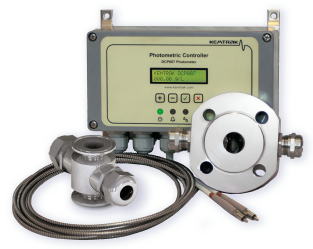
Petrochemical colour measurements of liquids are a vital part of many operations where precise process control and high product quality standards are desired.
Colour measurements are commonly used for number of purposes, including:
* colour addition control
* colour after distillation
* colour in paraffin
* colour removal control -
* colour avoidance -
* diesel oil inking
* fuel colour
A common colour scale used in the petrochemical industry is the Saybolt (ASTM) colour scale. The Saybolt (ASTM) colour scale covers the determination of the colour of refined oils such as un dyed motor and aviation gasoline, jet propulsion fuels, naphthas and kerosene, and, in addition, petroleum waxes and pharmaceutical white oils.
The Kemtrak DCP007 in-
The Kemtrak DCP007 photometer uses an absorbing wavelength to measure minute colour
changes in the process medium, while a second reference wavelength that is not absorbed
by the process medium compensates for turbidity and/or fouling of the optical windows.
The resulting measurements are very accurate with low drift and long-
Petrochemical colour measurement

| Kemtral TCP007 measurement principle |
| Kemtrak TCP007 turbidity meter |
| How it works |
| measurement |
| How it works |
| Measurement principle |
| Chemical general |
| Pharmaceutical |
| Petrochemical |
| Food and beverage |
| Pulp and Paper |
| Water and environment |
| Chemical concentration |
| Colour measurment |
| Interface detection |
| Leak detection |
| water in oil or fuel |
| Centrifuge |
| Filtration |
| Phase separation |
| Water detection |
| Chromographic separation |
| Colour ASTM saybolt |
| Interface detection |
| Water in fuel |
| Brewery |
| Dairy |
| Distillery |
| Food processing |
| Soft drinks |
| Wine |
| Alkali |
| Ozone |
| Chlorine dioxide |
| Chlorine |
| APHA Haze pt-c0 |
| Ozone |